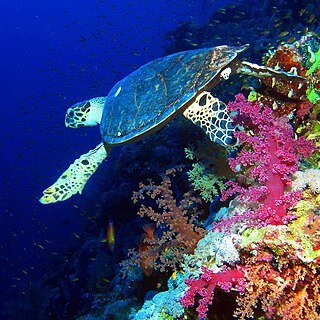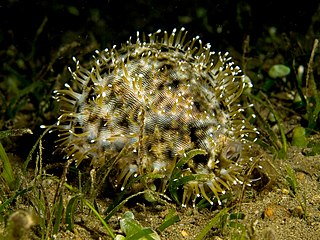
A spongivore is an animal anatomically and physiologically adapted to eating animals of the phylum Porifera, commonly called sea sponges, for the main component of its diet. As a result of their diet, spongivore animals like the hawksbill turtle have developed sharp, narrow bird-like beak that allows them to reach within crevices on the reef to obtain sponges.

Cypraea tigris, commonly known as the tiger cowrie, is a species of cowry, a large sea snail, a marine gastropod mollusk in the family Cypraeidae, the cowries.

Cantherhines dumerilii is a species of fish in the family Monacanthidae, the filefishes. Its common names include whitespotted filefish, barred filefish, orange-fin file, and yelloweye leatherjacket. It is distributed in the Indian and Pacific Oceans where it is found on coral reefs.
Homophyllia bowerbanki is a vulnerable species of coral found in the Pacific and Indian Oceans. This species is moderately common, but it is threatened by crown-of-thorns starfish predation and habitat loss.
Felimida dalli is a species of sea slug, a dorid nudibranch, a shell-less marine gastropod mollusk in the family Chromodorididae.

Myxilla incrustans is a species of demosponge. It is an encrusting species and is usually yellow.

Myxilla is a genus of demosponge belonging to the family Myxillidae. These sponges usually form encrustations on rock surfaces.

Pteraster militaris, the wrinkled star, is a species of starfish in the family Pterasteridae. It is found in the northern Pacific Ocean, the Arctic Ocean, the Barents Sea and the northern Atlantic Ocean.

Haliclona caerulea is a species of marine sponge in the family Chalinidae. It is an encrusting tubular sponge that grows anchored on rocky surfaces of coral reefs.
Dysidea arenaria is a species of marine sponge (poriferan) found in the Pacific Ocean. It is a member of the order Dictyoceratida, one of two sponge orders that make up the keratose or "horny" sponges in which a mineral skeleton is absent and a skeleton of organic fibers is present instead.
Iophon husvikense is a species of sea sponge first found on the coast of South Georgia island, in the south west Southern Ocean.

Clathria prolifera, commonly known as red beard sponge, is a species of sea sponge in the family Microcionidae. It is native to shallow water habitats in the western Atlantic Ocean from Prince Edward Island southwards to Florida and Mexico, and possibly Brazil. In the twentieth century it also became established on the west coast of the United States.

Gelliodes is a genus of sponges in the family Niphatidae.
Gelliodes fibrosa is a species of sponge found in shallow water in the Indian Ocean. It was first described in 1905 by the British zoologist Arthur Dendy, the type locality being the Gulf of Mannar, Sri Lanka. In 1925, the American zoologist Edmund Beecher Wilson described a species of sponge from North Sulawesi as Gelliodes fibrosa. In 2013, Carballo, Aquilar-Camacho, Knapp & Bell, decided that this was a homonym, a separate taxon from the original one described by Dendy, and gave the new species the name Gelliodes wilsoni.
Corticium candelabrum is a species of sponge in the order Homosclerophorida. It is native to the eastern Atlantic Ocean and the Mediterranean Sea where it inhabits the shallow sublittoral zone. The type locality is the Adriatic Sea.
Terpios hoshinota is a species of sea sponge belonging to the family Suberitidae. It is found on rocky shores in the Indo-Pacific region. This sponge forms blackish sheets which overgrow and kill corals, and is the causal agent for the so-called "black disease" of corals. Since being discovered in Guam in 1973, this sponge has been spreading to other areas of the Indo-Pacific region and threatening coral reefs from the Maldives to the South China Sea and eastern Australia.

Iophon is a genus of sponges belonging to the family Acarnidae. The genus has a cosmopolitan distribution.

Coelosphaeridae is a family of sponges belonging to the order Poecilosclerida. Species are found across the globe.

Acarnus is a genus of sponges belonging to the family Acarnidae. The genus has almost cosmopolitan distribution.
Ectyonopsis is a genus of demosponges in the family Myxillidae. They are mostly known from the waters surrounding Australia and from the Southern Ocean.










